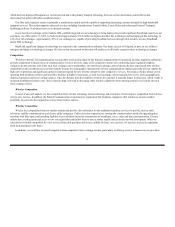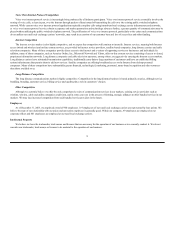FairPoint Communications 2005 Annual Report Download - page 20
Download and view the complete annual report
Please find page 20 of the 2005 FairPoint Communications annual report below. You can navigate through the pages in the report by either clicking on the pages listed below, or by using the keyword search tool below to find specific information within the annual report.
December 31, 2005, approximately 82% of our indebtedness bore interest at fixed rates rather than variable rates. After these interest rate swap agreements
expire, our annual debt service obligations with respect to borrowings under our credit facility will vary from year to year unless we enter into a new interest
rate swap or purchase an interest rate cap or other interest rate hedge. If we choose to enter into a new interest rate swap or purchase an interest rate cap or other
interest rate hedge in the future, the amount of cash available to pay dividends on our common stock may decrease. However, to the extent interest rates
increase in the future, we may not be able to enter into a new interest rate swap or purchase an interest rate cap or other interest rate hedge on acceptable terms.
In addition, prior to the maturity of our credit facility, we will not be required to make any payments of principal on our credit facility, and it is not
likely that we will generate sufficient funds from operations to repay the principal amount of our indebtedness at maturity. We therefore will need to refinance
our debt. We may not be able to refinance our outstanding indebtedness under our credit facility, or if refinanced, the refinancing may occur on less favorable
terms, which may materially adversely affect our ability to pay dividends. If we were unable to refinance our credit facility, our failure to repay all amounts
due on the maturity date would cause a default under our credit facility. We expect our required principal repayments under the term loan facility of our credit
facility to be approximately $588.5 million at its maturity in February 2012. Our interest expense may increase significantly if we refinance our credit facility
on terms that are less favorable to us than the terms of our credit facility.
We may also be forced to raise additional capital or sell assets and, if we are forced to pursue any of these options under distressed conditions, our
business and the value of your investment in our common stock could be adversely affected. In addition, these alternatives may not be available to us when
needed or on satisfactory terms due to prevailing market conditions, a decline in our business, legislative and regulatory factors or restrictions contained in the
agreements governing our indebtedness.
If we do not have sufficient cash to fund dividend payments, we would either reduce or eliminate dividends or, to the extent we were permitted to do so
under our credit facility and the agreements governing future indebtedness we may incur, fund a portion of our dividends with borrowings or from other
sources. If we were to use borrowings under our credit facility’s revolving facility to fund dividends, we would have less cash available for future dividends
and other purposes, which could negatively impact our financial condition, our results of operations and our ability to maintain or expand our business.
As of December 31, 2005, we had approximately $607.4 million of total consolidated indebtedness. Our substantial indebtedness could have important
adverse consequences to the holders of our common stock, including:
· limiting our ability to pay dividends on our common stock or make payments in connection with our other obligations, including under our credit
facility;
· limiting our ability in the future to obtain additional financing for working capital, capital expenditures or acquisitions;
· causing us to not be able to refinance our indebtedness on terms acceptable to us or at all;
· limiting our flexibility in planning for, or reacting to, changes in our business and the communications industry generally;
18
























